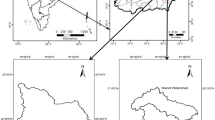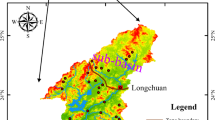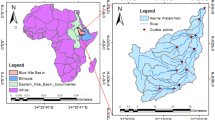Abstract
Runoff sediment process modeling is highly variable and nonlinear in nature. In the present study, an attempt has been made to develop a relationship between Soil Conservation Service Curve Number (SCS-CN) and Sedimen Yield Index (SYI) for the Narmada watersheds (Madhya Pradesh). Only area (A), delivery ratio (DR), and curve number (CN) were used as input for model development. High value of Nash–Sutcliffe efficiency of (η) 98.60 and 88.19 % for Shakkar watershed and for combined watersheds, respectively, shows that the proposed simplified SYI model is found to be suitable for the study area. The resulting higher (0.98 for Shakkar and 0.88 for combined watersheds) coefficient of determination (R 2) values strongly support the versatility of the derived relationship and invokes assessment of SYI from the available National Engineering Handbook (NEH-4) CN values. Thus, the prediction of SYI is important in order to adopt the suitable soil conservation measure in the study watershed for minimizing the soil erosion.







Similar content being viewed by others
References
AISLUS (1977) Priority delineation, Matatilla RVP, U.P Report No.Agri.484
AISLUS (1991) Methodology of Priority Delineation Survey, All India Soil & Land Use Survey Technical Bulletin 9. Department of Agriculture and Cooperation, New Delhi, India
Bagarello V, Ferro V, Giordano G (1991) Contributo alia valutazione del fattore di deflusso di Williams e del coefficiente di resa solida per alcuni bacini idrografici siciliani. Rivista di Ingegneria Agraria, Anno XXII(4), 238–251 (in Italian).
Brath A, Castellarin A, Montanari A (2002) Assessing the effect of land-use changes on annual average gross erosion. Hydrol Eart Syst Sci 6:255–265
Chaudhary RS, Sharma PD (1998) Erosion hazard assessment and treatment prioritization of Giri river catchment, North Western Himalayas. Indian J Soil Conserv 26(1):6–11
Church M, Slaymaker O (1989) Disequilibrium of Holocene sediment yield in glaciated British Columbia. Nature 337:452–454
De Vente J, Poesen J (2005) Predicting soil erosion and sediment yield at the basin scale: scale issues and semi-quantitative models. Earth Sci Rev 71:95–125
Dedkov A (2004) The relationship between sediment yield and drainage basin area. In: Sediment transfer through the fluvial system, 288th edn. IAHS Publishing, USA, pp 197–204, (Proceedings of a symposium held in Moscow, August 2004
Ferro V, Minacapilli M (1995) Sediment delivery processes at basin scale. Hydrol Sci J 40(6): 703–717
Flaxman (1971) Sediment yield Predictive Equation,Soil Conservation Service, Technical Service Centre Advisory –POI. U.S.D.A, Washington D.C
Garde RJ, Kothari UC (1987) Sediment yield estimation. J Irrig Power (India) 44(3):97–123
Grauso S, De Bonis P, Fattoruso G, Onori F, Pagano A, Regina P, Tebano C (2008) Relations between climatic-geomorphological parameters and suspended sediment yield in a Mediterranean semi-arid area (Sicily, southern Italy). Environ Geol 54:219–234
Ichim I, Radoane M (1987) A multivariate statistical analysis of sediment yield and prediction in Romania. In: Ahnert F (ed) Geomorphological models: theoretical and empirical aspects. Catena Suppl 10:137–146
Kumar S (1985) Reservoir sedimentation in Proc. Short term course on planning, design and operation of reservoir. Patna University, India, p 8
Kumar A, Sharma HC, Singh R, Prasad S (2011) Modelling of spring discharge in mid hills of North West Himalaya. Indian Journal of Soil Conservation 39(2), 95–99
Magalie D, Olivier C, Jean-Marie M, Manuel G (2009) A method for developing a large-scale sediment yield index for European river basins. J Soils Sediments 9:613–626. doi:10.1007/s11368-009-0126-5
Natural Resources Conservation Service (NRCS) (2001) Section 4: Hydrology.” National Engineering Handbook, Natural Resources Conservation Service. U.S. Department of Agriculture, Washington, DC
Ouyang D, Bartholic J (1997) Predicting sediment delivery ratio in Saginaw Bay watershed. 22nd National Association of Environmental Professionals Conference Proceedings. 19–23 May 1997, Orlando, pp 659–671
Patel DP, Dholakia MB, Naresh N, Srivastava PK (2012) Water harvesting structure positioning by using geovisualization concept and prioritization of mini-watersheds through morphometric analysis in the lower Tapi basin. J Indian Soc Remote Sens 40(2):299–312
Ponce VM, Hawkins RH (1996) Runoff curve number: has it reached maturity? J Hydrol Eng ASCE 1:11–18
Pyasi SK, Singh JK (2004) Sediment prediction by modelling runoff sediment process. Indian J Soil Conserv 32(2):100–107
Rallison RE (1980) “Origin and evolution of the SCS runoff equation.” Proc., Symp. on Watershed Management, Vol. II, ASCE, Reston, VA, 912–924
Rao HSS, Mahabaleswara H (1990) Prediction of the rate of sedimentation of Tungabhadra reservoir, Proc. Sym. On Erosion, Sedimentaion and Resource Conservation, Dehradun, India, Vol. 1, pp 12–20
Sarma S, Saikia T (2012) Prioritization of sub-watersheds in Khanapara–Bornihat area of Assam–Meghalaya (India) based on land use and slope analysis using remote sensing and GIS. J Indian Soc Remote Sens 40(3):435–446
Schiefer E, Slaymaker O, Klinkenberg B (2001) Physiographically controlled allometry of specific sediment yield in the Canadian cordillera: a lake sediment-based approach. Geogr Ann 83:55–65
Singh VP, Yadava RN (2003) Watershed Management. Allied publisher private limited. ISBN 81-7764-545-5
Soil Conservation Service (1956) Hydrology. National Engineering Handbook, Supplement A, Section 4, Chapter 10. Soil Conservation Service, USDA, Washington, D.C
Suresh M, Sudhakar S, Tiwari KN, Chowdary VM (2004) Prioritization of watersheds using morphometric parameters and assessment of surface water potential using remote sensing. J Indian Soc Remote Sens 32(3):249–259
TT ENERGY PVT. LTD (2010) Environmental management plan of Ting Ting, H.E. project. Sikkim., Project Report, August, pp 12
Vanoni VA (1975) Sediment deposition engineering. ASCE Manuals and Reports on Engineering Practices, p 54
Walling DE (1983) The sediment delivery problem. J Hydrol 65:209–237
Williams JR, Berndt HD (1972) Sediment yield computed with universal equation. J Hydraul Div ASCE 98:2087–2098, HY2
Wischmeier WH, Smith DD (1978) Predicting rainfall-erosion losses - a guide to conservation planning. AH-537. U. S. Department of Agriculture, Washington, D.C.
Author information
Authors and Affiliations
Corresponding author
Rights and permissions
About this article
Cite this article
Gajbhiye, S., Mishra, S.K. & Pandey, A. Simplified sediment yield index model incorporating parameter curve number. Arab J Geosci 8, 1993–2004 (2015). https://doi.org/10.1007/s12517-014-1319-9
Received:
Accepted:
Published:
Issue Date:
DOI: https://doi.org/10.1007/s12517-014-1319-9




